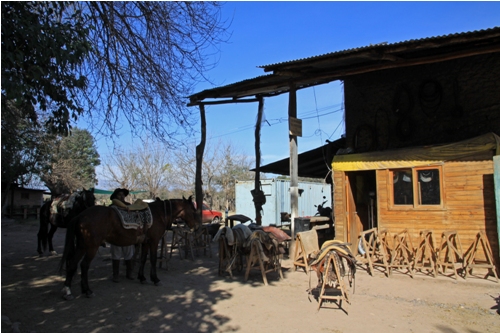
It feels like so long ago that I was getting my teeth stuck into the most succulent and tender of steaks, drinking fine malbecs and spreading my legs for the juiciest empanadas I could find. But the memories are still fresh in my mind and I promised when I crossed to Bolivia that I would get back to Argentina, not physically, but on this here blog to let you know all about the rest of my foodie experiences there.

It seems fitting to start with a quintessentially Argentine experience on an estancia in the countryside just outside of Salta. I spent a morning horseriding through patchwork fields of brown and green, parched rocky river beds and eucalypus groves with the Andes as a backdrop and gauchos as my guides. This was followed by a traditional asado prepared by master of the house, the exuberant Enrique.

This was one of the best meals I had on my entire trip, and not because the food stood out above the rest. This was simple, rustic country cooking, hearty and wholesome, also humble. But a great meal is about so much more than the food; it was not so much about what we ate but how we ate it and the role that the food played in uniting a group of people from different cultures.
Enrique opens his table (and plenty of bottles of wine) each day to feed and water the people who pass through his ranch for a day’s horseriding. On the day I visited there were New Zealanders, Australians, Irish, Welsh, British, Venezuelans and Americans. Some of the tourists spoke Spanish, most did not. Some of the South Americans spoke English, most did not. Yet we still managed to have a thoroughly enjoyable lunch pointing, miming, laughing and translating.

The sirloin steak was plump and juicy, seasoned with a delicious marinade of garlic, chilli and plenty of salt. I noticed that Enrique wasn’t touching the steak and asked why. He took great relish in telling me that sirloin steak is for the tourists,
“We Argentines prefer real meat with real flavour – rib-eye, ribs and offal.”
“I like that stuff” I protested and was rewarded with a big, fatty, charcoaled pork rib. It did have a lot of flavour, but unfortunately it was a bit overcooked so rather hard work and on the dry side. The little sausages that Enrique was tucking into, on the otherhand, oozed porky juices and fat when cut open and were packed full of flavour.
The chimmichurri was different from others I’d had, more like a salad dressing than the seasoned oils I’d tasted because a lot of vinegar had been added. I didn’t use it on the steak because I thought it would overpower the delicate flavour of the meat. The girls who made the sides must have been thinking along the same lines as it turned up in a lot of the salads.
My favourite of the salads was a simple mix of tomato, parsley and onion mainly because a mild vinegrette and minimal seasoning allowed the taste of the tomatoes, grown locally, to come through. The fava beans and lentil salads were also good; although smothered in chimmichurri, the pulse stood up to the bold flavour.
The roast vegetables were loaded with garlic and herbs, the potatoes were salty and crispy and I loved the presentation of the pumpkin puree, although the puree itself could have done with some salt and pepper.
Food is one of the fundamental things that defines a culture, and for individuals in that culture it can contribute hugely to their sense of identity and belonging. It is also a wonderful means of communicating across cultures, an international language that breaks down barriers. Many of the people in the group did not speak the same language, but you could tell from the sticky fingers, contented smiles and empty plates wiped clean with bread that we shared something in common; our enjoyment of a wonderful meal.
Sayta Cabalgatas – Chicoana, Salta, Argentina; +54 9 387 683 6565; saytacabalgatas@hotmail.com